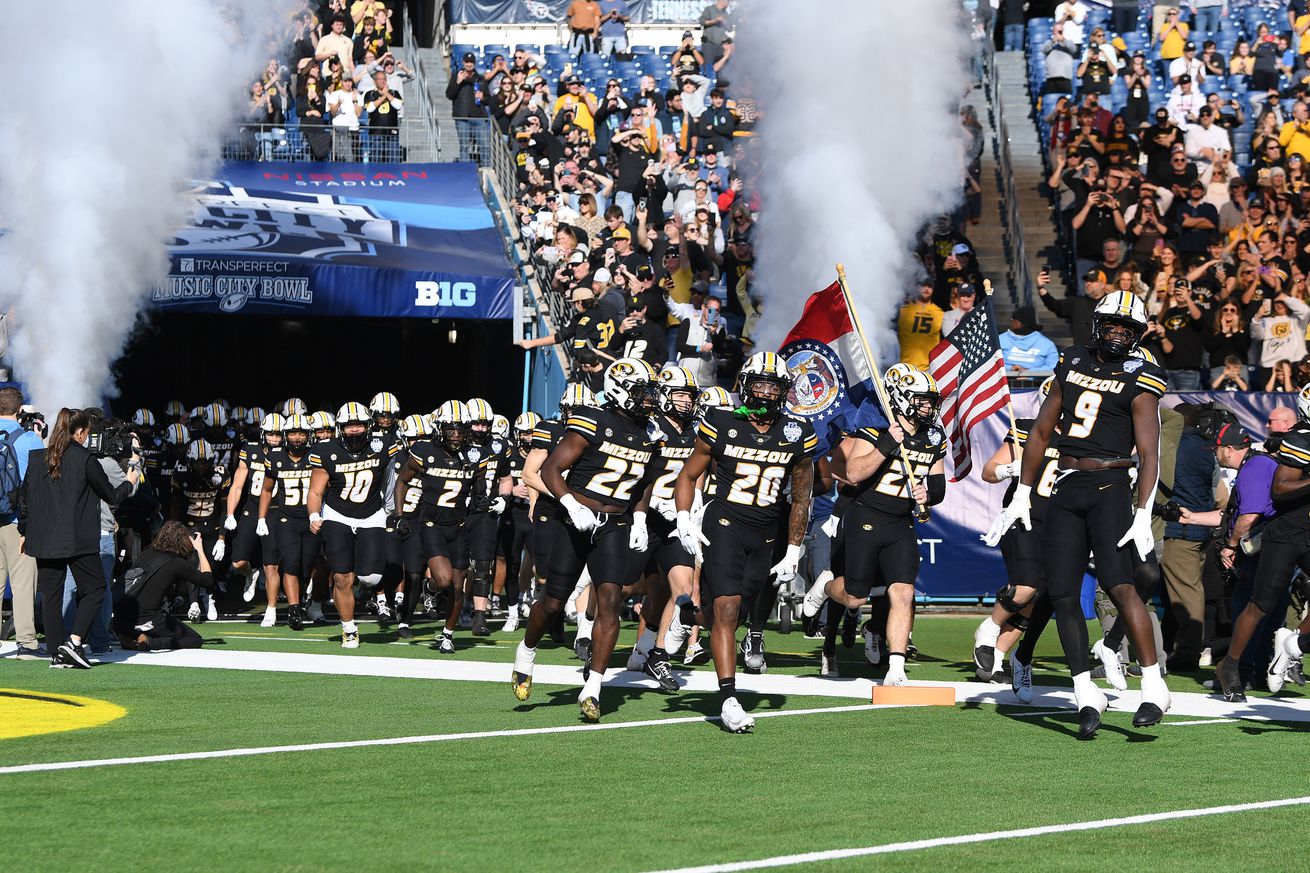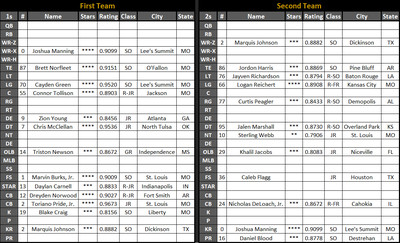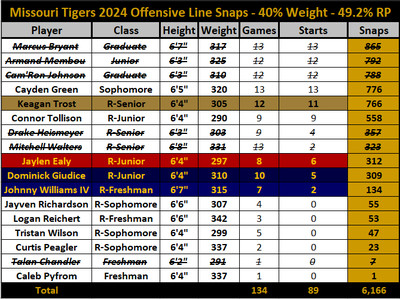
Who comes back counts, but WHAT comes back is the important part.
The 2024 Postmortem series is officially done and we can begin looking into the 2024 team! Rejoice! The best way to project 2025 success is by looking at the remains of the 2024 team and figuring out how much production returns on the offensive and defensive sides.
The gentleman who created both Rock M Nation and the SP+ metric system, Bill Connelly, has a measurement called “returning production”, a metric that attempts to quantify the value of production coming back, rather than the value of individuals coming back. His pieces are paywalled, but to me, it’s worth checking out every year as high returning production (roughly 80%) tends to lead to a 5-6 point jump in SP+. In fact – at this time two years ago – I pointed out that a 5-6 point jump in SP+ for Missouri would mean an increase from a 9.4 in ‘22 to a 14.4 or 15.4 in ‘23; at the end of the ‘23 season that featured a Missouri squad returning 78% of the prior years’ production, said Mizzou team finished with a 19.3 rating in SP+, nearly a full 10 point jump!
The 2025 season is one year closer to the roster normalization that the COVID bonus year threw out of whack but, of course, with multiple ongoing cases litigating eligibility, it’s impossible to tell if we’ll ever stop the changes enough to embrace a “new normal”. To be sure, there are still lingering super seniors and, of course, the ever-active transfer portal will continue to make roster management much more different than what we were used to even five years ago. While that could mean that Bill C’s returning production number might not be 100% accurate, it’s certainly as close as you can get in a given timeframe and he’s done better, more thorough work than anyone else out there. Here’s how his formula projects Missouri:
- Overall Returning Production: 60% – 51st
- Offensive Returning Production: 44% – 100th
- Defensive Returning Production: 58% – 68th
Again, as a reference point, at this time last year the 2024 Missouri Tigers’ returning production was 68% overall (31st), 79% offense (16th), and 58% defense (68th). So, yeah, for the first time in two years Eli Drinkwitz’s Missouri Tigers are not going to be anywhere close to the top of returning production in the country.
The current national average for returning production is 53.7%, almost fifteen points lower than where Missouri is coming in. As far as the SEC goes, Missouri’s 60% returning production ranks 51st in the country but 9th in the SEC, with Kentucky, Tennessee, Arkansas, South Carolina, Texas, Georgia, and Ole Miss returning less production than the good guy Tigers.
The strength of the 2023 Missouri squad was that it brought back a ton of production to an SEC that was losing a lot of production, specifically at quarterback. In 2024, Missouri once again ranked near the top of the league in production (and once again boasted a proven quarterback) to a league that once again was losing a bunch of production and quarterbacks.
But that’s not the case in 2025.
Again, returning production talks about improvement or regression in quality, not an increase or decrease in wins, but the good-news-take-away here is that Missouri returns the most defensive production in the conference and is in the middle of the pack overall while their peers who they will be playing – Arkansas, South Carolina, Mississippi State – are fairly close in number to Mizzou’s RP.

Here’s Missouri’s 2024 end-of-season two-deep based off of production and snap counts. The gaps are players that were on the 2024 roster that won’t be on the 2025 roster:

Pretty empty at the top of the offensive chart, huh?
Today let’s break down Missouri’s returning offensive production! On offense, returning production looks at the following metrics and is given the following weights:
- Returning Quarterback Passing Yards: 22% weight
- Returning Running Back Rushing Yards: 3% weight
- Returning Wide Receiver/Tight End Receiving Yards: 35% weight
- Returning Offensive Line Snaps: 40% weight
Bill C has said it countless times and I’ve echoed it: experience in the passing game (i.e. quarterbacks and receivers) matters the most. But, given Bill’s updated weight allocation, the only thing that isn’t a good predictor of future success is running back rushing yards. Let’s break down what’s coming back and from whom (italicized/struck-through players are not on the 2025 roster).
Quarterback Passing Yards – 22% weight – 7.7% returning production

Brady Cook and Drew Pyne – the only gentlemen who threw a pass for the 2024 Missouri Tigers football team – are gone. In their place is Beau Pribula, who attempted 35 passes last year and has thrown 56 total passes in his 3 years of college football. And he’s the most experienced quarterback on the Missouri roster. Interesting!
Running Back Rushing Yards – 3% Weight – 51.7% Returning Production

Ahmad Hardy’s production is nearly the entire returning production in this classification and, of course, he was at Louisiana-Monroe last year. Luckily, Jamal Roberts and Tavorus Jones return, and Curtis Luper running backs tend to make a leap in the second or third-years of heavy usage. Might that portend that we see a leap from Roberts? Maybe! But with a 3% weight it doesn’t matter too much what’s returning from the rushing category as far as determining future success.
Receiver/Tight End Receiving Yards – 35% Weight – 61.9% Returning Production

While returning receiving yards holds the highest returning production, 1844 yards of that belongs to Kevin Coleman, Jr. and Xavier Loyd, two dudes who famously were not on last year’s team. While the return of starter-level players Brett Norfleet and Speedy Johnson offer some bright spots, the vast majority of this category is looking to two one-year rentals and rotational pieces to provide the jump in consistency that was lacking from last year’s group.
Offensive Line Snaps – 40% Weight – 49.2% Returning Production

And the category that is weighted the heaviest also features a returning production number that is the second-lowest. Turns out losing three starters and the two main backups is bad for projecting future success! Even with four additions to the line, only one – Keagan Trost – was used as a frequent starter and the other three were spot starters who barely cracked 300 snaps on the year (i.e. 20 snaps less than Tiger backup Mitchell Walters). It’ll be a lot of juggling and acclimation for this group and that uncertainty is one of the biggest things that is projected potential offensive regression in 2025.
Conclusion
Missouri returns almost nothing from the quarterback and receivers, has two backups and a strong transfer replacement for its departed two-headed running back, and has assorted one-year loaners and transfer backups along the line. That doesn’t mean that this offense can’t be good to elite in 2025, it just means that there’s enough questions that the most likely outcome is regression.
Next week we’ll check out the defense. Methinks that you’ll enjoy that one more than this one!